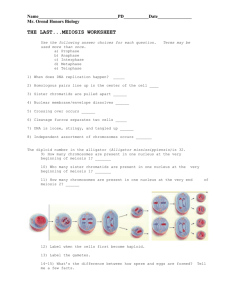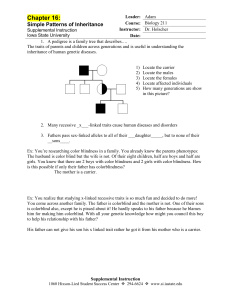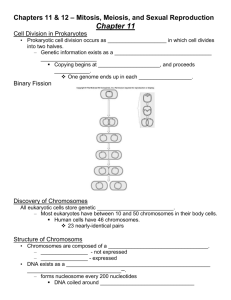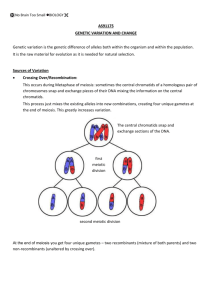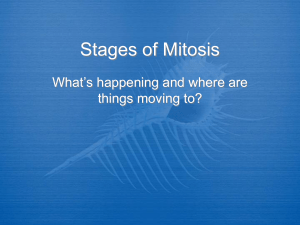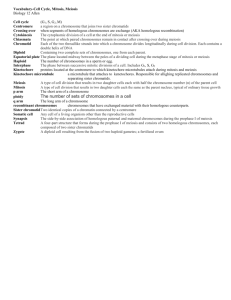File - Year 2 Main page
advertisement
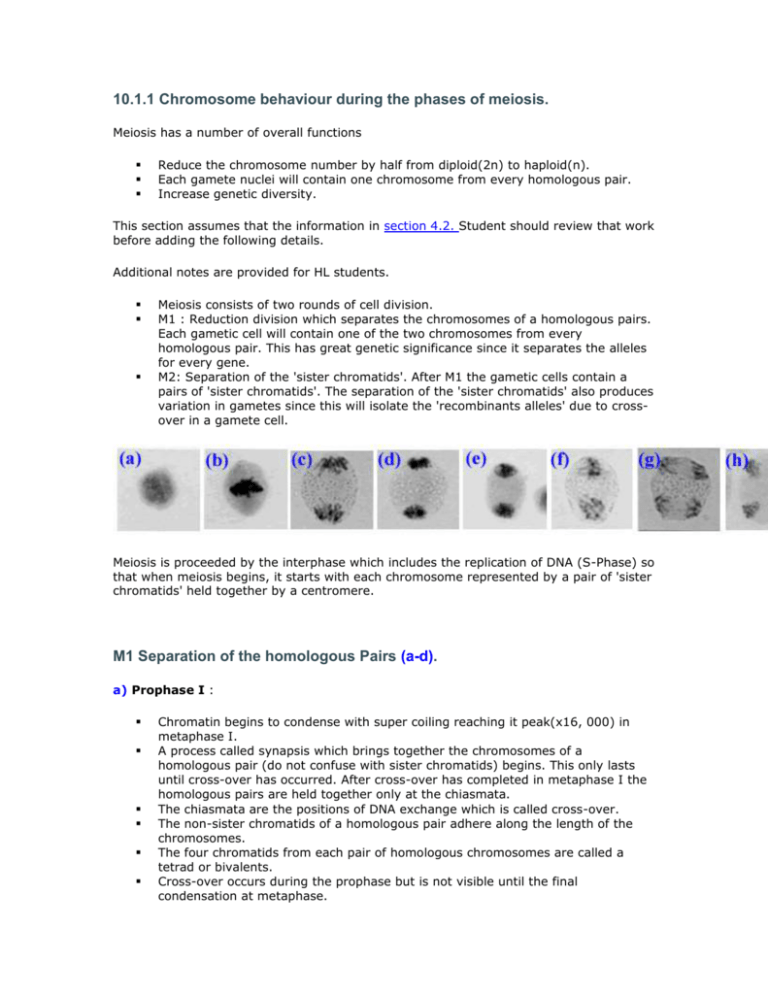
10.1.1 Chromosome behaviour during the phases of meiosis. Meiosis has a number of overall functions Reduce the chromosome number by half from diploid(2n) to haploid(n). Each gamete nuclei will contain one chromosome from every homologous pair. Increase genetic diversity. This section assumes that the information in section 4.2. Student should review that work before adding the following details. Additional notes are provided for HL students. Meiosis consists of two rounds of cell division. M1 : Reduction division which separates the chromosomes of a homologous pairs. Each gametic cell will contain one of the two chromosomes from every homologous pair. This has great genetic significance since it separates the alleles for every gene. M2: Separation of the 'sister chromatids'. After M1 the gametic cells contain a pairs of 'sister chromatids'. The separation of the 'sister chromatids' also produces variation in gametes since this will isolate the 'recombinants alleles' due to crossover in a gamete cell. Meiosis is proceeded by the interphase which includes the replication of DNA (S-Phase) so that when meiosis begins, it starts with each chromosome represented by a pair of 'sister chromatids' held together by a centromere. M1 Separation of the homologous Pairs (a-d). a) Prophase I : Chromatin begins to condense with super coiling reaching it peak(x16, 000) in metaphase I. A process called synapsis which brings together the chromosomes of a homologous pair (do not confuse with sister chromatids) begins. This only lasts until cross-over has occurred. After cross-over has completed in metaphase I the homologous pairs are held together only at the chiasmata. The chiasmata are the positions of DNA exchange which is called cross-over. The non-sister chromatids of a homologous pair adhere along the length of the chromosomes. The four chromatids from each pair of homologous chromosomes are called a tetrad or bivalents. Cross-over occurs during the prophase but is not visible until the final condensation at metaphase. During the condensation of the chromosomes, a point is reached when the homologous pair seems to repel each other except at regions called chiasma. The centromere's of one pair of 'sister chromatids' particularly repels the centromere region of the other in the homologous pair. Crossing over increases the genetic diversity of the gametes and therefore increases variation in successful fertilizations. The process of forming ‘recombinants’ is dealt with in section 10.2 ‘gene linkage’. Nuclear membrane breaks down and the nucleoli disintegrates. In animal cells the centrioles are placed at either pole of the cell and serves as a focal point for the organisation of the spindle microtubules. Microtubules attach to the centromere's of each pair of homologous chromosomes. (b) Metaphase I: Homologous pairs are aligned on the equatorial plate. Homologous pairs have been held together by the chiasmata but this is not shown for clarity. Each 'pair of sister chromatids' in a homologous pair is attached to microtubule. Each half of the spindle is attached to the opposite poles. (c) Anaphase I: The spindle microtubules contract pulling the pair of 'sister chromatids' to one pole and the other pair of 'sister chromatids' for the same homologous pair to the other pole. It seems that this process is a combination of spindle contraction (75%) and a centromere motor (25%) pulling the pairs of chromatids along the spindle. At this point the chiasmata break down and the exchange of lengths of DNA including alleles of genes is complete. (d) Telophase I: The genetic material is now organised at the two pole of the cell. Each pole contains a pair of 'sister chromatids' , one from each homologous pair. In some species the nuclear envelop re-forms whilst in others there is an immediate progression to M2 and prophase II. M2 Separation of the 'Sister Chromatids (e-i). (e) Prophase II: Chromosomes condense again if required. There has been no chromosome replication but each chromosome is represented by a pair of 'sister chromatids'. The spindle forms in a new plane for each of the two cells. The positioning of the plane for the spindle is critical for later development. The 'sister chromatids' attach to the spindle microtubule at the region of their centromere. The 'pairs' then move around, beginning to align for the metaphase II. (f) Metaphase II: The pairs of sister chromatids line up at the equator of each cell. The are now very condensed and at their most visible. The cohesin joining together the arms of the chromatids has broken down except at the centromere. The chromosome takes on the characteristic open X -shape. Each of the chromatids will separate at the next stage. (g) Anaphase II: The combination of spindle contraction and the centromere 'motor' pulling on the spindle microtubule, pulls the sister chromatids apart. One chromatid from each pair goes to each pole. Each chromatids can now be referred to as a chromosomes again. The chromosomes from the pair of 'sister chromatids' are not identical due to the exchange of DNA during cross-over (not shown in diagram). (h) Telophase II : The chromosomes gather at opposite pole and form the new haploid nuclei. The nuclear envelope material that has remained within the cytoplasm re-forms around the sets of chromosomes. There are now two nuclei per cell, each is haploid. (i) Cytokinesis: The cells divide to form a tetrad of four haploid nuclei. The type of division depends on this being an animal or plant cell. In the sexually mature human male the process of meiosis and the production of mature motile sperm cells (haploid) takes over a month. In the human female the process begins during embryonic development but then undergoes a period of 'dormancy'. The cell still diploid is held at prophase I until ovulation many years later. The completion of meiosis does not actually end until fertilisation and then in humans this results in a single gametic cell and not the four as described above. (see reproduction unit). Other species have refined this process in different ways as an adaptation to their own ecology. top 10.1.2 Outline the formation of chiasmata in the process of crossing over. (a) Interphase: During the interphase each of the chromosomes in a homologous pair replicates. The two copies of a chromosome are held together by a centromere. The replicated chromosome pair are described as 'sister chromatids'. (b) Prophase I: Molecules, 'cohesin's', hold the homologous pairs close together. This facilitates the homologous pair joining to the same spindle microtubule. The exchange of DNA between parallel arms of the non-sister chromatids takes place. (c) Prophase I -Metaphase I: Still in prophase the DNA molecule exchanges length of DNA. In metaphase the chiasmata are more obvious as the 'cohesin's' are broken down. The homologous pairs seem to repel each other particularly at the centromere. However they remain linked together at the chiasma. This is also the peak phase of condensation. (d) Anaphase I: The separation of the homologous pairs in the anaphase finally breaks the chiasma connections. complete. The DNA exchange on the arms of the chromosomes is (e) Anaphase II: In anaphase II the 'sister chromatids' are separated into different cells. Some of the chromosomes are new recombinants of DNA containing part maternal and part paternal chromosomes. In effect this has created new combinations of linked genes. top 10.1.3 Genetic variation due to cross over and random orientation in metaphase 1. Genetic variation in gametes: 1 Crossover. Increasing genetic diversity in gametes which in turn increases genetic diversity of the populations. Crossover as described in the previous section creates new combinations of linked genes. This creates new genotypes for the gametes that are not due to random assortment. 2. Random orientation. At Metaphase I, homologous pairs aligned on the equatorial plate of the dividing cell. The diploid cells are the centre row. They will divide, as for anaphase I,vertically. The homologous pair are both held on the same spindle microtubule (green dashed line). Anaphase I will separate the homologous pair and therefore their alleles. However with this cell (diploid number = 4) then there are two possible orientations of the homologous pairs on the equatorial plate. RANDOM orientation means that all orientations are equally possible. In this example the number of possible gametes is 4. In general the calculation of the number of possible gametes = 2n Homo sapiens 2n=46 , n= 23 therefore number gametes = 2n = 8,388,608. Genetic variation: Combining cross-over with random orientation creates a great deal of variation. The greater the diploid number and the greater the degree of cross-over, the greater the diversity. There are other genetic factors that increase the genetic variation of a population still further: Random fertilisation in which any possible gamete form the male (2n) can randomly fertilise any other possible gamete from the female (2n) = 22n. Gene mutation Chromosome mutation Populations are subject to other means of increasing genetic variation. Students might like to consider what these might be, think about the definition of a population and the factors that affect population size. Implications and the synoptic view: This topic reveals the source of genetic variation. That is the source of variation on which natural selection acts. The random orientation, cross-over and mutation are random processes. The natural selection of a particular phenotype is not. This topic requires us to regard sexually reproducing populations as genetically diverse and that diversity within the population changes from one generation to the next. Living things possess a genetic program which distinguishes them from other types of matter. The population of a species shows genetic varation. Knowing this makes it difficult to be specific about how a population will respond to a change in their environment. Therefore biology requires a 'population thinking' approach so that phenomena might be understood. This is what distinguishes Biological Science from the Physical Sciences. top 10.1.4 Mendel's law of Independent assortment. In his work Mendel followed patterns of inheritance of characteristics in plants. He is perhaps most famous for his work on pea plants from which he developed and published his laws of inheritance. Law of Independent Assortment: This law states that allele pairs separate independently during the formation of gametes. Therefore, traits are transmitted to offspring independently of one another. top 10.1.5 The relationship between Mendel's law of independent assortment and meiosis. Mendel's law of independent assortment has been covered in the previous section 10.1.3 by discussing the random orientation of the chromosomes at metaphase I. We should remember that Mendel tracked the tracked the inheritance of physical characteristics and traits (phenotypes) not the actual alleles or chromosomes. Mendel's law of independent assortment> allele pairs separate independently during the formation of gametes. In terms of meiosis: Random orientation of homologous chromosomes in metaphase I This work is covered in section 10.2.1 top Click4Biology: Topic 10.1 Meiosis OCC | LabBanks | StudentBlog | TeacherBlog | Audio | Reading | Brights | Edge| EOL 10.1 Meiosis / 10.2 Dihybrid crosses and gene linkage / 10.3 Polygenic inheritance / Meiosis: Meiosis is to biology, like then keystone is to an arch bridge. It is a pivotal subject which will allow you to understand so many of the 'grand' concepts. Read these pages, make models, watch animations and then hopefully its significance will dawn on you......"so that's how it is!" . 10.1.1 Chromosome behaviour during the phases of meiosis. 10.1.2 Outline the formation of chiasmata in the process of crossing over. 10.1.3 Genetic variation due to cross over and random orientation in metaphase 1. 10.1.4 Mendel's law of Independent assortment. 10.1.5 The relationship between Mendel's law of independent assortment and meiosis. Home 01. Statistical Analysis 02. Cells 03. Chemistry of life 04. Genetics 05. Ecology & Evolution 06. Human Physiology 07. Proteins & Nucleic Acids 08. Respiration & Photosynthesis 09. Plant Science 10. Genetics 11. Human Health A. Human Nutrition B. Physiology of exercise C. Cells and Energy D. Evolution E. Neurobiology & behaviour F. Microbes & Biotechnology G. Ecology & Conservation H. Further Human Physiology Theory of Knowledge Additional Information about us contact us site map disclaimer Links UNESCO Bioethics BEEP Patana Science Pages Bio Links Shambles
